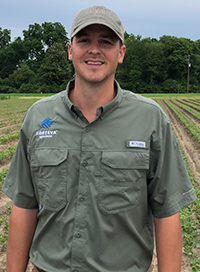 In a perfect crop year, rice would be planted by early April and tillered and flooded before June 1. We would apply overlapping residual herbicides with precise timing, and post-flood herbicide applications would not be required. Surrounding crops would also never be an issue, and every herbicide would be tank-mix-friendly.
In a perfect crop year, rice would be planted by early April and tillered and flooded before June 1. We would apply overlapping residual herbicides with precise timing, and post-flood herbicide applications would not be required. Surrounding crops would also never be an issue, and every herbicide would be tank-mix-friendly.
Unfortunately, not every season is a perfect one. In 2020, for example, the USDA reported that only 67% of Arkansas rice was planted by May 10.
Reaching full yield potential in a late crop requires minimizing weed competition and maximizing grain fill. Here are five weed control tips to help you reach your yield goals at harvest.
1. Protect against barnyardgrass
Barnyardgrass populations are high in many areas. Lack of activation of Command herbicide, tillage escapes or burndown misses can result in one-leaf to tillering barnyardgrass competing with young rice plants.
To help remedy this situation, add Clincher® SF herbicide or RebelEX® herbicide to your next post-residual shot. Because barnyardgrass is usually much smaller in size when early postemergence applications are occurring, add a 12- to 15-ounce rate of Clincher or a 16- to 18-ounce rate of RebelEX with either Command or Prowl herbicide. Using Clincher or RebelEX in this situation to spray small grass may also eliminate the need for a post-flood herbicide application.
2. Apply herbicides in high moisture conditions
Remember: Herbicide applications should be applied with adequate soil moisture. The wetter, the better — with mud-sticking-to-your-boots scenarios preferable.
3. Choose the right tool for herbicide-resistant weeds
In many parts of the Mid-South, we are seeing barnyardgrass populations exhibiting resistance to both Facet herbicide and propanil — two of the most commonly used pre-flood products on the market. If you suspect populations resistant to Facet and/or propanil in your field, consider treating with RebelEX. RebelEX gives you two active ingredients — penoxsulam and cyhalofop — and is competitively priced compared with other propanil-containing products.
4. Proactively fit products to field scenarios
Grasp® SC herbicide has a strong fit, especially if you have neighboring cornfields. Grasp SC is one of the only barnyardgrass herbicides that can be safely used around corn. In my area, we run a lot of Grasp SC plus Permit herbicide between Command breaking and a pre-flood application. This also helps buy time before the pre-flood application. Permit is added because yellow nutsedge is usually a problem during this time.
5. Knock out pigweed in row rice
We are seeing an increase in row rice acres this year, and pigweed is the first weed problem that comes to mind after grass in this production system. Traditionally, the old standby was 12 ounces per acre of Grandstand® R herbicide plus 3 quarts per acre of propanil. Loyant® herbicide is the new standard. Loyant is pure death on pigweed, controls ALS-resistant flatsedge and is an effective control option for many black-seeded weeds and sedges, which is increasingly important in this production system.
Grasp® SC, RebelEX®, Clincher®, Grandstand® and Loyant® herbicides all have a great fit in Mid-South rice production. Best of luck using these five tips to maximize rice production in imperfect growing seasons.
Clincher® SF, Grandstand® R, Grasp® SC, Loyant® and RebelEX® are not registered for sale or use in all states. Contact your state pesticide regulatory agency to determine if a product is registered for sale or use in your state. Always read and follow label directions.
The More You Grow
Find expert insights on agronomics, crop protection, farm operations and more.